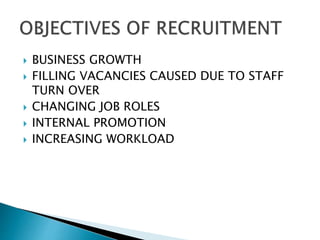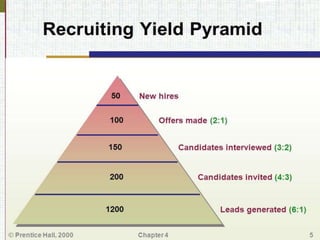RECRUIMENT
- 2. Recruitment can be defined as the process of finding out prospective candidates for filling actual vacancies in an organisation. THE PROCESS OF RECRUITMENT IS ONE OF THE MOST SINGNIFICANT ASPECT FOR OPERATING A BUSINESS SUCCESSFULLY.
- 3. “RECRUITMENT IS THE PROCESS OF SEARCHING FOR PROSPECTIVE EMPLOYEES AND STIMULATING THEM TO APPLY FOR JOBS IN THE ORGANISATION.
- 5. BUSINESS GROWTH FILLING VACANCIES CAUSED DUE TO STAFF TURN OVER CHANGING JOB ROLES INTERNAL PROMOTION INCREASING WORKLOAD
- 6. BUSINESS GROWTH- RECRUITMENT IS MANDATORY FOR THE BUSINESS TO GROW,SINCE A BUSINESS WHICH IS RERUITING INDICATES ITS GROWTH. CHANGING JOB ROLES- IN PRESENT WORLD, WORK IS CHANGING CONTINUOUSLY. THE SKILL THAT SEEM TO BE OF VALUE TODAY MIGHT TURN REDUNDANT NEXT YEAR AND A NEW SET OF SKILLS WILL BE NEEDED. INTERNAL PROMOTION- ORGANISATIONS PRACTICE MOTIVATING THEIR EMPLOYEES TO GO FOR MORE CHALLENGING AND HIGHER PAID JOBS WITH IN THE ORGANISATION.
- 8. NUMBER OF CONTACTS: ORGANISATIONS ALWAYS INTEND TO ATTRACT MORE THAN THE REQUIRED CANDIDATES AS THEY WANT TO MAKE THE BEST CHOICE OUT OF A LARGE NUMBER OF CANDIDATES. TYPE OF CONTACTS- IT INVOLVES THE TYPES OF PEOPLE OF PEOPLE TO BE MADE AWARE ABOUT THE JOB VACANCIES ACCORDING TO JOB DISCRIPTION AND JOB SPECIFICATION.
- 9. ONCE A RECRUITMENT PLAN IS FINASED REPRESENTING THE NUMBER AND TYPE OF POTENTIAL CANDIDATES;THEY MUST BE ATTRACTED IN SUCH A WAY THAT THEY OFFER THEMSELVES FOR EMPLOYMENT. HENCE ,IT IS ESSENTIAL TO IDENTIFY THE SOURCES FROM WHICH THESE CANDIDATES CAN BE ATTRACTED.
- 10. AFTER THE FINAL DECISION ABOUT THE SOURCES OF SELECTING THE POTENTIAL CANDIDATES, THE PROCEDURE OF CONTACTING THESE SOURES IS INITIATED.RECRUITMENT IS TWO WAY PROCESS AND THERE ARE MAINLY TWO PARTIES. 1-RECRUITER 2-RECRUITEE
- 11. THE FINAL AIM IS TO ATTRACT MORE AND MORE CANDIDATES SO AS TO MAINTAIN FLEXIBILITY IN SELECTION,NO MATTER WHAT METHOD OF RECRUITMENT IS USED.THE ORGANISATION STARTS RECEIVING APPLICATIONS FROM POTENTIAL CANDIDATES AS SOON AS THE SOURCE OF RECRUITMENT ARE CONTACTED.
- 12. THE PROCESS OF CLASSIFYING APPLICANTS,IN ORDER TO HIRE THOSE WHO ARE MORE COMPETENT FOR THE JOB, IS CALLED SELECTION. THE SELECTION PROCESS INVOLVES EXPERT EMPLOYEES WHO ARE PROFICIENT IN USING SELECTION TESTS,CONDUCTING INTERVIEWS ETC.
- 13. IT IS NECESSARY TO ENHANCE THE EFFFICIENCY OF RECRUITMENT ATTEMPTS IN FUTURE . IT SHOULD BE KEPT IN MIND THAT RECRUITMENT IS AN EXPENSIVE PROCESS,INVOLVING COSTS SUCH AS THE RECRUITER”S SALARY,ADVERTISING COST,MANAGERS SALARIES AND VARIOUS OTHER COSTS. IT IS THUS NECESSARY TO EVALUATE THE PROCESS OF RECRUITMENT.
- 14. FACTOR AFFECTING RECRUITMENT (A) External Force- Supply and demand Unemployment rate Labour market Political legal Image (B) Internal Force- Recruitment Policy HRP Size of the firm Cost Growth and expansion
- 15. Strategy Development (1) Make or Buy- firm must decide whether to hire less skilled employees and invest on training and education programms, or they can hire skilled labour and professionals. (2) Technology sophistication. (3) Where to look (4) How to look. Internal Recruitments- (i) Present employees (ii) Employee Referrals- It can be a good source of recruitment. When employees recommend successful referrals, they (the former) are paid monetary incentives which are called “finders fees’’.
- 16. (iii) Former employees- It is also an internal source of applicant. Some retired employees may be willing to come back to work on a part time basis or may recommend someone who would be interested in working for the company. External Recruitment- (i) Professional or Trade associations. (ii) Advertisements. (iii)Wall-ins, write –ins and talk-ins.
- 17. Source of Recruitment- (1) Present employees- Professional or Trade Associations Advertisements Employment Exchanges Campus Recruitment (2) Employee Referrals- Wall-ins and write-ins Consultants (3) Former Employees- Contractors Displaced Persons (4) Previous Applicants- Radio and Television Acquisitions and mergers Competitors E-Recruiting
- 19. Internal Recruitment- Advantage- (i) It is less costly. (ii) Candidates are already oriented towards company. (iii) Enhancement of employee morale and motivation. (iv) Organization have better knowledge about the internal candidates. (v) Good performances is rewarded.
- 20. Disadvantages- (i) It perpetuates the old concept of doing things. (ii) Candidates current work may be affected. (iii) Politics play greater role. (iv) Morale problem for those not promoted.
- 21. External Recruitment- Advantages- (i) Benefits of new skills, new talents and new experience to organizations. (ii) Compliance with reservation policy becomes easy. (iii) Scope for resentment, jealousies avoided.
- 22. Disadvantages- (i) Better morale and motivation associated with internal recruiting is denied to the company. (ii) It is costly. (iii) Chances of creeping in false positive and false negatives errors. (iv) Adjustment of new employees to the organization culture takes longer time.
- 23. Importance of Recruitment- (i) Determine the present and future requirements of the firm in conjunction with its personnel planning and job analysis activities. (ii) Increase the pool of job candidates of minimum cost. (iii) Help increase the success rate of the selection process by reducing the number of visibly under qualified or overqualified job applicants. (iv) Help reduce the probability that job applicants, once recruited and selected, will leave the organization only after a short period of time.
- 24. IMAGE OF ORGANISATION UNATTRACTIVE JOB INTERNAL POLICIES OF THE ORGANISATION BUDGETARY SUPPORT GOVERNMENT INTERFERENCE
- 25. IMAGE OF ORGANISATION- The appropriate candidate may not be willing to apply for the job because of the negative image of the organisation in their mind. Unattractive job - if the job itself is not lucrative but image of the organisation is positive, even then the job will not be able to grab the attention of the qualified candidate. INTERNAL POLICES OF ORGANISATION-The policy of filling job vacancies through internal sources can restrict the organisation to select the talented candidates from the external sources. BUGETARY SUPPORT- Recruiting candidates from external sources needs money ,but at times because of inadequate budget , the organisation may not conduct the recruiting activities for a long time. GOVERNMENT INTERFERENCE- Government interface in the functioning of organisation, particularly in the central and state local bodies and quasi government organisation also act as an obstacle for recruitment .
- 27. When a certain company is approached for getting a certain work or activity done ,it is regarded as outsourcing . Outsourcing is implemented by almost every organization. Service providers or third party providers are the common names used for the firm providing the facility of outsourcing.
- 28. In present era ,the management of most companies prefer online recruitment ,also called e-recruitment or internet recruitment. It notify about available vacancies, online application form ,e –payment of fees etc.
- 29. The recruitment of such persons who are already working in other renowned organization organizations which may also be competitors in the industry is referred to as poaching in recruitment. More attractive and higher packages are offered to them by the organization in order to attract competent individuals working some where else.




























